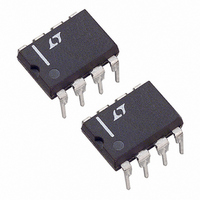LT1072IN8 Linear Technology, LT1072IN8 Datasheet - Page 8

LT1072IN8
Manufacturer Part Number
LT1072IN8
Description
IC SWTCHNG REG 1.25A HI-EFF 8DIP
Manufacturer
Linear Technology
Type
Step-Down (Buck), Step-Up (Boost), Cuk, Flyback, Forward Converterr
Datasheet
1.LT1072CN8PBF.pdf
(16 pages)
Specifications of LT1072IN8
Internal Switch(s)
Yes
Synchronous Rectifier
No
Number Of Outputs
1
Voltage - Output
1.25 ~ 40 V
Current - Output
1.25A
Frequency - Switching
40kHz
Voltage - Input
3 ~ 60 V
Operating Temperature
-40°C ~ 125°C
Mounting Type
Through Hole
Package / Case
8-DIP (0.300", 7.62mm)
Lead Free Status / RoHS Status
Contains lead / RoHS non-compliant
Power - Output
-
Available stocks
Company
Part Number
Manufacturer
Quantity
Price
Company:
Part Number:
LT1072IN8
Manufacturer:
LT
Quantity:
5 510
Company:
Part Number:
LT1072IN8
Manufacturer:
NS
Quantity:
5 510
Part Number:
LT1072IN8#PBF
Manufacturer:
LINEAR/凌特
Quantity:
20 000
LT1072 OPERATIO
rough guide to calculate LT1072 power dissipation. For
more details, the reader is referred to Application Note 19
(AN19), “Efficiency Calculations” section.
Average supply current (including driver current) is:
I
DC = switch duty cycle
Switch power dissipation is given by:
R
Total power dissipation is the sum of supply current times
input voltage plus switch power:
In a typical example, using a boost converter to generate
12V @ 0.12A from a 5V input, duty cycle is approximately
60%, and switch current is about 0.65A, yielding:
Temperature rise in a plastic miniDIP would be 130°C/W
times 0.34W, or approximately 44°C. The maximum
ambient temperature would be limited to 100°C
(commercial temperature limit) minus 44°C, or 56°C.
In most applications, full load current is used to calculate
die temperature. However, if overload conditions must
also be accounted for, four approaches are possible. First,
if loss of regulated output is acceptable under overload
conditions, the internal thermal limit of the LT1072 will
protect the die in most applications by shutting off switch
current. Thermal limit is not a tested parameter, however,
and should be considered only for non-critical applications
with temporary overloads. A second approach is to use the
larger TO-220 (T) or TO-3 (K) package which, even without
a heat sink, may limit die temperatures to safe levels under
overload conditions. In critical situations, heat sinking
of these packages is required; especially if overload
conditions must be tolerated for extended periods of time.
LT1072
8
SW
SW
I
P
P
l
P
P
lN
IN
= switch current
SW
TOT
SW
TOT
= LT1072 switch “on” resistance (1Ω maximum)
= 6mA + 0.65(0.004 + DC/40) = 18mA
≈ 6mA + I
= (I
= (0.65)
= (l
= (5V)(0.018A) + 0.25 = 0.34W
SW
lN
)(V
)
2
2
SW
IN
• R
• 1Ω • (0.6) = 0.25W
) + P
(0.004 + DC/40)
SW
SW
• DC
U
The third approach for lower current applications is to
leave the second switch emitter open. This increases
switch “on” resistance by 2:1, but reduces switch current
limit by 2:1 also, resulting in a net 2:1 reduction in I
switch dissipation under current limit conditions.
The fourth approach is to clamp the V
than its internal clamp level of 2V. The LT1072 switch
current limit is zero at approximately 1V on the V
2A at 2V on the V
externally clamped between these two levels with a diode.
See AN-19 for details.
LT1072 Synchronizing
The LT1072 can be externally synchronized in the frequency
range of 48kHz to 70kHz. This is accomplished as shown
in the accompanying figures. Synchronizing occurs when
the V
To avoid disturbing the DC characteristics of the internal
error amplifier, the width of the synchronizing pulse
should be under 1µs. C2 sets the pulse width at ≈ 0.35µs.
The effect of a synchronizing pulse on the LT1072
amplifier offset can be calculated from:
KT
t
f
I
V
R3 = resistor used to set mid-frequency “zero” in LT1072
With t
offset voltage shift is ≈2.2mV. This is not particularly
bothersome, but note that high offsets could result
if R3 were reduced to a much lower value. Also, the
synchronizing transistor must sink higher currents with
low values of R3, so larger drives may have to be used. The
transistor must be capable of pulling the V
200mV of ground to ensure synchronizing.
q
S
S
C
C
∆V
= 26mV at 25°C
= pulse width
= pulse frequency
= LT1072 V
= LT1072 operating V
C
frequency compensation network.
OS
S
pin is pulled to ground with an external transistor.
= 0.35µs, f
=
(
KT
q
(
C
(t
source current (≈ 200µA)
S
S
)(f
C
= 50kHz, V
I
S
C
pin. Peak switch current can be
) I
(
C
C
voltage (1V to 2V)
+
R3
V
C
C
(
= 1.5V, and R3 = 2KΩ,
C
pin to a voltage less
C
pin to within
C
pin and
1072fc
2
R














